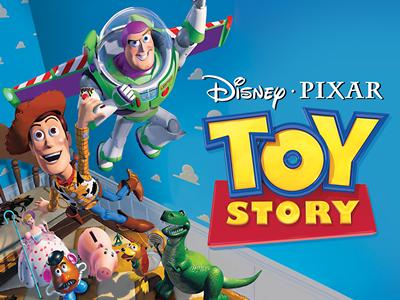Toy Story at 25: how Pixar’s debut evolved tradition rather than abandoning it

Dr Malcolm Cook Associate Professor in Film Studies, reflects on the impact and legacy of the Disney-Pixar film franchise 'Toy Story' which first hit cinema screens in the USA on 19 November, 1995.
The release of Toy Story 25 years ago marked a paradigm shift in animation and cinema history. It was the first full-length feature by Pixar Animation Studios and the world’s first fully computer-animated film. Yet, from our present-day perspective, Toy Story can be seen as evolutionary rather than revolutionary – a marker of already developing trends in the 1990s and a continuation of enduring traditions from the history of animation.
Premiering on November 19 1995, the novelty of the computer techniques used by Pixar was central to Disney’s marketing of Toy Story. Press reviews invariably highlighted the technological innovation of the film.
Toy Story’s plot anticipated this battle between old and new. The film follows traditional cloth cowboy doll, Woody, as he deals with his young owner Andy’s affections being usurped by the shiny plastic and electronics of spaceman Buzz Lightyear. This mimics how computer animation threatened to replace hand-drawn animation techniques. But the narrative’s final reconciliation between Woody and Buzz, both equally loved by Andy, is suggestive of the cautious innovation the film entails.
A Toy Story world
Toy Story is undoubtedly one of the most important and influential animated features of the 20th century. In this regard it is only equalled by Snow White and the Seven Dwarfs (1937), the first full-length animated feature film.
The film spawned three sequels, released in 1999, 2010 and 2019, which together have earned more than US $3 billion (£2.2 billion) in global box office takings. Alongside these films, there have been two television specials, three short films and several TV spin offs.
Anyone visiting Disney theme parks around the world can encounter Toy Story characters and rides, eat at the film’s famous Pizza Planet, and even ride through Andy’s room.
You’ll find the film’s characters in any toy shop, supermarket or children’s clothes store. Innumerable books based on the films – aimed at both children and a general audience – have been published, as well as academic studies.
Toy Story is widely credited with influencing the regular production across other major studios of computer-animated films. As the highest-grossing film released in 1995, it demonstrated that computer-animated films could be lucrative. Foreseeing this success, Steve Jobs took a gamble, taking Pixar public days after the film’s release. It paid off in a hugely successful IPO, which valued the company at US $1.5 billion (£1.1 billion).
Critical success was equally important – the film was nominated for four Oscars and John Lasseter, director and co-writer, was recognised with a Special Achievement Award. Animation was being taken seriously again for the first time in decades. Without this success the Shrek, Ice Age and The Despicable Me and Minions franchises arguably wouldn’t exist.
Evolving tradition
Nevertheless, it’s now clear Toy Story was a transition rather than an absolute break with the past.
Many of the people who worked on the film, particularly Lasseter, attended the California Institute of the Arts, which had long-established links with Disney. As such, Toy Story was rooted in the traditional character animation techniques that had been refined at the Disney studio in the 1930s. Lasseter had been working at Disney when Tron (1982) was in production, a film whose use of early computer-generated sequences inspired the young animator but was far more radical and alienating to mainstream audiences than Pixar’s first feature would be.
Long before Toy Story, Pixar had already helped introduce the use of digital tools in traditional animation production with the Computer Animation Production System (CAPS) – the development of which started in 1986. The results of CAPS were first seen briefly in the final shot of a rainbow in The Little Mermaid (1989) and extensively in The Rescuers Down Under (1990), such as the spectacular opening flight sequence.
Disney’s early 90s films all benefited from extensive CAPS-enabled animation, including the incorporation of CGI environments – such as the ballroom sequence in Beauty and the Beast (1991), the cave escape and magic carpet character in Aladdin (1992) and the wildebeest stampede in The Lion King (1994). Also, everything in those films had been processed through new computer techniques in the years before Toy Story was released.
It is also worth considering that the distribution and exhibition of Toy Story were decidedly traditional. If you saw Toy Story in the cinema on its original release you would have seen it projected using 35mm celluloid film, like every other film at the time. Toy Story might have been the first fully digital production, but its exhibition depended upon recording those digital images onto analogue film strips. This was a technology that had been in use, largely unchanged, since moving pictures first appeared a century earlier.
The physical limitations in this process are partly responsible for Toy Story not being released in the UK until March 22 1996, four months after the US. This was almost the last moment when staggered international releases were commonplace. This is because internet piracy, global marketing and shareholder reporting have since placed pressure for worldwide same day-and-date releases, with ever shorter theatrical windows.
From a cultural perspective, Toy Story is a product of its time. Its narrative about “boys toys” reflects the contemporary male-centric Pixar brain trust. The prominent return of a more empowered Bo Peep in Toy Story 4 and the lead Black characters in the forthcoming Soul (2020), alongside internal personnel changes, suggest the studio is taking some note of criticism about its lack of diversity. Such developments also signal a moving away from the culture that produced the original Toy Story.
Recognising the historical context of Toy Story can make us reconsider some of the promotional claims put forward on its behalf, but this need not diminish the true value of the film. Rather, it can help deepen our appreciation of its lasting appeal. Toy Story at 25 remains an outstanding film for its time, but nevertheless enjoyable, moving, thought-provoking today.
This article was originally published on The Conversation. Read the original article.
